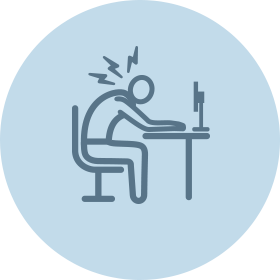



Services
Treatments
Pain Management Services in San Diego, CA
We offer a wide range of pain management services to help restore your body back to its natural state of optimal health.
Joint Pain
Description:
The pes anserine bursa is located on the inside of the knee, and it can become inflamed due to overuse or injury. This injection is specifically designed to target this bursa, reducing pain and inflammation caused by conditions such as bursitis or repetitive strain injuries. It provides rapid relief and can help restore mobility, making it a popular choice for those suffering from knee pain that doesn't respond to conservative treatments.
Trochanteric Bursa Injection
Bursa Injection
Description:
The trochanteric bursa is located on the outer side of the hip, and inflammation in this area is commonly associated with trochanteric bursitis or hip tendinitis. A targeted injection can provide relief by reducing swelling and pain, helping you regain your hip's full range of motion. This procedure is particularly effective for patients dealing with persistent pain from activities such as walking or climbing stairs.
Learn moreShoulder Joint Injections
Description:
Shoulder pain can arise from a variety of conditions, including arthritis, rotator cuff tendinitis, or shoulder impingement. A corticosteroid injection is a powerful tool used to reduce inflammation and alleviate pain in the shoulder joint. The injection contains a steroid that works by calming the immune response, providing significant relief, and improving mobility for those suffering from chronic shoulder issues.
Learn moreGenicular Nerve Block
Description:
If you're dealing with chronic knee pain from osteoarthritis or other knee conditions, a genicular nerve block can be an effective solution. This procedure targets the nerves around the knee joint to block pain signals, providing immediate relief. It can also serve as a diagnostic tool to help pinpoint the exact source of pain, helping guide further treatment.
Learn moreKnee Joint Injections
Description:
Knee aspiration is a minimally invasive procedure designed to relieve the pressure and discomfort caused by excess fluid buildup in the knee joint. Fluid can accumulate due to conditions such as knee arthritis, infection, or injury. By using a needle to withdraw the fluid, this procedure helps reduce swelling and pain, restoring knee function and mobility.
Learn moreTherapeutic Botox for Migraines
Description:
For individuals suffering from chronic migraines, Botox injections offer a unique treatment option. Botox works by blocking the release of chemicals that contribute to migraine pain, and it is injected into specific areas around the head and neck. These injections can reduce the frequency and intensity of migraines, providing long-term relief for many patients.
Learn moreHeadaches/Migraine
Description:
Migraines that involve tension headaches or neck pain may benefit from an occipital nerve block. This procedure involves injecting an anesthetic or corticosteroid near the occipital nerves at the back of the head. The goal is to block pain signals and reduce inflammation, leading to relief from chronic headaches and associated symptoms.
Learn moreSuborbital Nerve Block
Description:
A suborbital nerve block targets the nerves beneath the eyes and is often used for facial pain or migraine-related symptoms. By reducing inflammation in these key nerve areas, this procedure can provide significant relief for patients experiencing pain around the eyes, forehead, or temples.
Learn moreSciatic Nerve Block
Description:
For those suffering from sciatica—pain caused by compression or irritation of the sciatic nerve—a sciatic nerve block can offer effective relief. This procedure involves the injection of a local anesthetic near the sciatic nerve, helping to block pain signals and reduce inflammation. It's often used for conditions like herniated discs or spinal stenosis that cause shooting leg pain.
Learn moreCluneal Nerve Block
Description:
The cluneal nerves provide sensation to the skin of the lower back and upper buttocks. If you're experiencing lower back pain or lumbar radiculopathy, a cluneal nerve block can offer significant relief by targeting these nerves with an anesthetic or corticosteroid injection. This procedure helps alleviate pain and improve mobility for patients dealing with nerve-related discomfort.
Learn moreTrigger Point
Description:
Trigger points are areas of muscle tightness that can lead to muscle pain, stiffness, and even headaches. Trigger point injections involve injecting a local anesthetic or corticosteroid directly into the affected muscle. This helps reduce inflammation, relax the muscle, and improve range of motion, providing effective relief for individuals with chronic muscle pain.
Learn moreFacet Joint Injections
Description:
The facet joints in the lower back can become inflamed or injured, leading to chronic lumbar pain. Facet joint injections, which typically contain a corticosteroid, target these joints to reduce inflammation and relieve pain. This treatment is especially beneficial for patients suffering from facet joint arthritis or other degenerative conditions that affect the spine.
Learn moreDurable Medical Equipment (DME)
Description:
We offer a wide range of Durable Medical Equipment (DME) to support patients with musculoskeletal conditions. Our products help provide stability, reduce pain, and promote healing. Some of the key DME offerings include:
Lumbar Pain: Lumbar braces and support cushions to relieve lower back pain and improve posture.
Knee Pain: Knee braces, orthotics, and supports designed to stabilize the knee joint and reduce discomfort.
Hip Pain: Hip belts and supports to alleviate pressure on the hips and improve mobility.
Wrist Pain: Wrist braces and splints to provide relief from conditions such as carpal tunnel syndrome and sprains.
Cervical Pain: Neck braces and cervical collars for neck strains, herniated discs, or spinal instability.
Personal Injury Pain Management
Description:
Personal injuries can include anything from sprains and fractures to soft tissue injuries. Pain management for personal injury focuses on reducing acute pain, inflammation, and speeding up recovery.
Medical Options:
Nonsteroidal Anti-Inflammatory Drugs (NSAIDs): These are commonly used for managing mild to moderate pain, especially if there's swelling or inflammation.
Example: Ibuprofen (Advil), Naproxen (Aleve)
How it Works: NSAIDs block the enzymes responsible for the production of prostaglandins, chemicals that promote inflammation, pain, and fever.
Acetaminophen (Tylenol): A pain reliever that is often used when inflammation is not a major factor.
Example: Acetaminophen
How it Works: Acts on the brain to reduce the perception of pain but does not reduce inflammation.
Physical Therapy & Rehabilitation: Often used to support recovery and prevent long-term pain after injuries.
Example: Stretching, strengthening exercises, heat/cold therapy
Chronic Pain Management
Description:
Chronic pain is pain that persists for weeks, months, or even years. It often results from conditions like arthritis, fibromyalgia, or nerve damage. Managing chronic pain requires a combination of medications, therapies, and lifestyle changes.
Medical Options:
Anticonvulsants: These are often used to treat nerve-related pain, such as that from diabetic neuropathy or post-herpetic neuralgia.
Example: Gabapentin, Pregabalin
How it Works: They reduce nerve excitability, helping to ease nerve pain.
Topical Pain Relief: Topical treatments like creams or patches can be applied directly to the affected area to provide localized relief.
Example: Capsaicin cream, Lidocaine patches
How it Works: Capsaicin works by reducing pain receptors in the skin, while lidocaine blocks nerve signals in the area.
Physical Therapy & Exercise: Strengthening muscles and increasing flexibility can significantly help in chronic pain management.
Example: Yoga, Pilates, aquatic therapy
Cognitive Behavioral Therapy (CBT): Psychological therapy to help people cope with the emotional aspects of chronic pain.
How it Works: CBT teaches patients to identify and change negative thought patterns related to pain, improving coping strategies.
Cancer Pain Management
Description:
Cancer pain can be caused by the tumor itself, treatment (like chemotherapy), or related complications such as nerve damage or bone metastasis. Managing cancer pain focuses on both symptom relief and improving the quality of life.
Medical Options:
Steroids: Used to reduce inflammation and alleviate pain, especially for pain related to tumors pressing on nearby structures.
Example: Dexamethasone, Prednisone
How it Works: Steroids decrease inflammation and swelling, often reducing pain associated with tumor growth.
Bisphosphonates & Denosumab: These drugs are used to treat bone pain caused by cancer that has spread to the bones.
Example: Zoledronic acid (Zometa), Denosumab (Xgeva)
How it Works: These medications help strengthen bones and reduce pain from bone metastases.
Nerve Blocks & Epidural Injections: These are procedures where anesthetic or steroid injections are used to block pain signals directly at the source.
Example: Epidural steroid injections, Nerve block for spinal pain
How it Works: These injections target specific nerves or areas of the spinal cord to reduce pain.
QME
Description:
Lorem ipsum dolor sit amet, consectetur adipiscing elit, sed do eiusmod tempor incididunt ut labore et dolore magna aliqua. Ut enim ad minim veniam, quis nostrud exercitation ullamco laboris nisi ut aliquip ex ea commodo consequat.
Learn moreOffice Hours
- Monday8:00am - 4:30pm
- Tuesday8:00am - 4:30pm
- Wednesday8:00am - 4:30pm
- Thursday8:00am - 4:30pm
- Friday8:00am - 4:30pm
- Saturday & SundayBy Appointment Only
Get in Touch
Contact Info
San Diego, CA 92101




